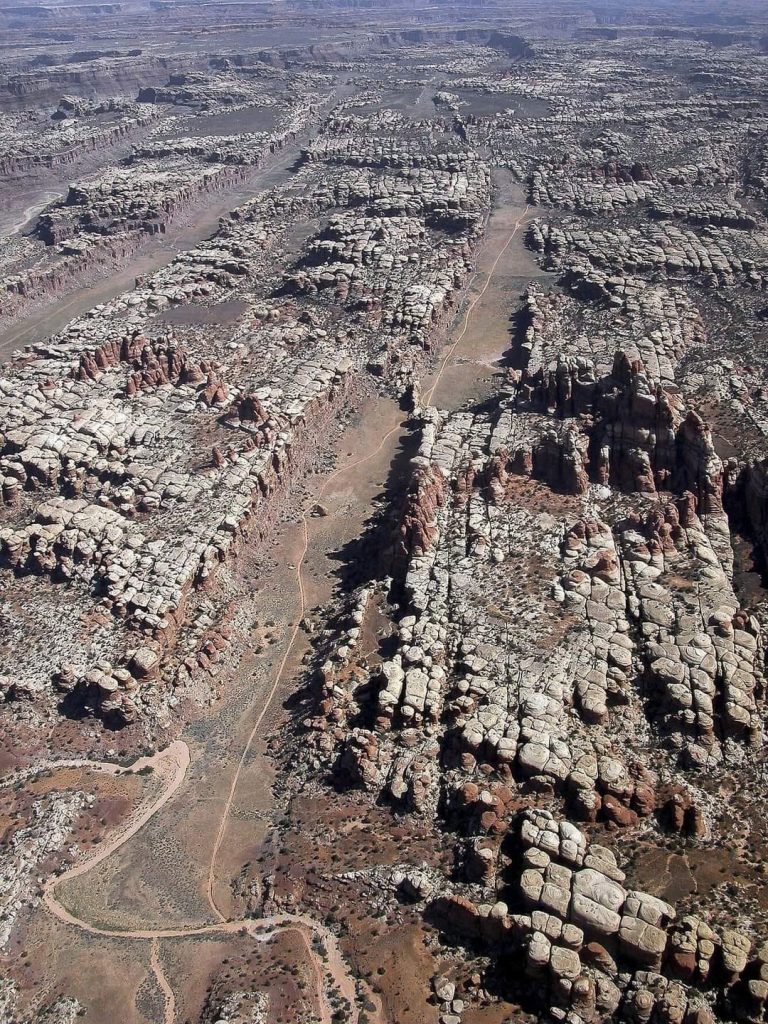Deep within the rugged expanse of Utah’s Canyonlands National Park lies one of Earth’s most fascinating geological wonders—the Ancient Grabens. Spanning 16 miles and plunging up to 246 feet deep, these dramatic formations tell a compelling story of the relentless forces of nature at work over millions of years. To the untrained eye, the grabens may seem like just another feature of the park’s breathtaking landscape, but for geologists and curious travelers alike, they offer an unparalleled window into the Earth’s dynamic history.

The Birth of the Grabens: A Story Written in Stone
The Legacy of an Ancient Sea
Imagine traveling back in time 300 million years to an era when the American Southwest looked nothing like the arid terrain we see today. Instead, a vast inland sea stretched across what is now Utah, covering the land in shimmering blue waters. But as the climate shifted and this ancient sea gradually receded, it left behind far more than just the remnants of a forgotten era—it deposited enormous layers of salt, in some places exceeding a thousand meters in thickness. Over time, layer upon layer of sedimentary rock—limestone, sandstone, mudstone, and siltstone—built up on top of the salt, creating the mesmerizing bands of color that characterize the Canyonlands region today. Shades of deep red, stark white, muted gray, and earthy brown streak through the rock formations, each layer representing a different chapter in the Earth’s geological history.
The Dance of Salt and Stone: Nature’s Hidden Forces
What makes the grabens so extraordinary is not just their striking appearance but the powerful geological forces that gave birth to them. Beneath the surface, the ancient salt deposits did not remain inert. Unlike the more rigid rock layers above, salt has a peculiar property—it behaves like a slow-moving fluid when subjected to pressure over long periods. This process, known as “salt tectonics,” set the stage for the grabens’ formation.
As the landscape above subtly shifted and eroded, the underlying salt layer acted as a natural lubricant, allowing the overlying rock to crack, sink, and slide. Some sections of land collapsed downward while others remained elevated, creating the network of trenches and plateaus that define the grabens today. This continuous movement, occurring over millions of years, has sculpted one of the most visually stunning and scientifically significant terrains in North America.
A Living Geological Laboratory
Modern Technology Meets Ancient Landscapes
While the grabens have existed for millions of years, modern technology has provided scientists with a deeper understanding of how they formed. In 2014, NASA’s Landsat 8 satellite captured high-resolution images of the grabens, revealing their intricate patterns from space. These breathtaking images, processed by NASA Earth Observatory experts Jesse Allen and Robert Simmon, have provided researchers with an unprecedented view of salt tectonics in action. By studying these formations from above, scientists have gained valuable insights into the way salt and rock layers interact—a process that continues to shape landscapes around the world.
The Artistry of Erosion
But nature’s sculpting hand has not stopped working. Wind, rain, and dramatic temperature shifts relentlessly chip away at the grabens, slowly peeling back layers of rock to expose even deeper secrets hidden within the Earth’s crust. This constant process of erosion ensures that the grabens remain an evolving feature, a living textbook of geological transformation. Each crack, crevice, and exposed rock face tells a story of time, change, and the incredible forces shaping our planet.
A Destination Like No Other: The Grabens Today
For those who venture into the Maze District of Canyonlands National Park, the grabens offer far more than just a scenic view—they provide an awe-inspiring journey through time. Unlike many geological phenomena that remain buried deep within the Earth’s crust, the grabens lay bare the hidden forces that have molded our world for hundreds of millions of years.
Scientists from around the globe travel here to study these formations, using them as a key reference point for understanding similar salt tectonic processes occurring in other parts of the world. But the grabens are not just for scientists. Adventurous travelers, nature lovers, and geology enthusiasts alike find themselves drawn to this remarkable landscape, captivated by its rugged beauty and the mysteries it holds.
There is something deeply humbling about standing atop one of these formations and gazing out over the canyons. The sheer scale of the grabens reminds us of the vastness of geological time and the immense forces that continue to shape the land beneath our feet. Every crack and crevice tells a story that spans eons, from the slow evaporation of an ancient sea to the subtle yet powerful movement of salt deep within the Earth.
A Glimpse Into Earth’s Past and Future
What makes the grabens truly special is their ability to reveal what is typically hidden from view. Most geological processes occur out of sight, deep underground, or across timescales too vast for humans to comprehend. But here, in this remarkable corner of Utah, we can witness the results of these processes firsthand. The grabens serve as a natural time capsule, preserving evidence of Earth’s ever-changing landscape and offering clues about the forces that will continue to shape it in the future.
For those lucky enough to explore the Maze District, the grabens offer more than just an unforgettable experience—they offer a connection to something much greater than ourselves. They remind us that the Earth is not static but alive, constantly shifting, reshaping, and revealing new wonders. They stand as a testament to the incredible power of natural forces, a place where time is etched into the land itself, waiting to be read by those who take the time to look.
In the end, whether you come to Canyonlands as a scientist, an adventurer, or simply a curious observer, the grabens will leave a lasting impression. They invite us to see the world not just as it is today, but as it has been for millions of years—and as it will continue to be shaped for eons to come.





